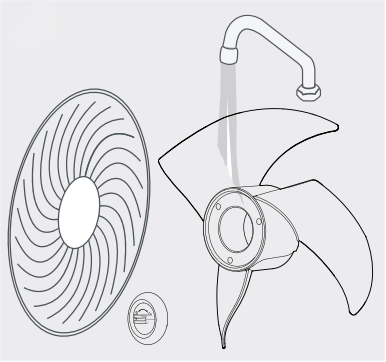Swapping out an old ceiling fan might sound like a hassle, but it’s actually a manageable DIY project — especially when you’ve got the right tools and a little guidance. Whether you're upgrading for better airflow, more modern design, or quieter operation, the process is simpler than you might think.
In this post, we’ll use the DREO CLF521 as an example — a modern ceiling fan that’s designed for easier installation and smoother performance. But even if you’re working with a different fan, the general steps we’ll cover can help you confidently make the switch.
What You’ll Need:
- Ladder
- Phillips Screwdrivers
- Voltage tester
- Wire strippers
- Wire connectors (usually included with your fan)
- Your new ceiling fan (and its manual)
DREO Pro Tips:
Turn off the power: To avoid the risk of electrical shock, ensure the power is disconnected by switching off the circuit breakers to the outlet box connected to the wall switch location.
Follow the installation guide: Always refer to the manual included with your fan — each model may have slight variations.
Call a professional if needed: If you ever feel unsure about the wiring, don’t hesitate to call in a licensed electrician.
Double-check installation: Before use, always confirm that the ceiling fan is securely and properly installed.
Clean regularly: Keep your fan clean and dust-free for peak performance year-round.
Step 1: Cut the Power
Before you even touch the fan, head to your breaker box and switch off the power to the room. Double-check by flipping the fan switch and using a voltage tester at the ceiling wires. Safety first!
Step 2: Take Down the Old Fan
Remove the fan blades first — it makes everything easier.
Unscrew the canopy to access the wiring and mounting bracket.
Carefully disconnect the wires (black, white, and ground) and remove any wire connectors.
Unscrew the old mounting bracket and take it down.
Step 3: Check the Ceiling Box
Not all electrical boxes are fan-rated. If yours isn’t labeled for fan support, it’s worth replacing with one that is — especially if your new fan is on the heavier side.
Step 4: Install the New Bracket
Depending on your ceiling setup, you'll need to choose the appropriate method to secure your ceiling bracket:
For existing fan-rated outlet box: Use machine screws (not provided) to secure the fan. Make sure the box is rated for a fan that weighs up to 35 lbs (15.9 kg) or less.

For support structure installation: Use wood screws and washers(included). Drill 9/64" pilot holes into the support structure to securely install the ceiling bracket.

Note: Make sure the installation site is roomy enough to allow fan blades to rotate. There is at least seven feet from the floor to fan blades' tips.
Step 5: Assemble the Blades
Now that your ceiling bracket is ready, it’s time to assemble the blades:
You can choose either the front or back side of the blades—whichever looks best to you!

Align the two blade slots with the vertical tabs in the ceiling fan body.

Partially insert screws and washers into the blade’s holes, then use a screwdriver to securely tighten them.

Pro tip:
- For optimal performance, make sure to use the fan blades consistently, whether on the front or reverse side.
- Carefully follow the instructions on the blades; improper installation could lead to the fan not functioning correctly.
Step 6: Assemble the Downrod
The downrod is essential for hanging your ceiling fan securely. Follow these steps:
Remove the pre-installed setscrews and downrod pin.

Insert the canopy, followed by the yoke cover, and pass all wires to one side of the downrod to keep them untangled.

Slide the downrod into the yoke of the motor assembly, aligning the holes, re-install the downrod pin and clip.

Tighten the setscrew with a screwdriver.

Note: DO NOT hand tighten setscrew.
Slide the yoke cover back into place.

Note: DO NOT hand tighten setscrew.
Step 7: Hang the Ceiling Fan & Install the Light Kit
Place the downrod ball into the ceiling bracket and ensure the slot aligns with the inner lock. Rotate the downrod until it clicks securely into place.

Connect the wires: white (grounded) from the ceiling to white from the fan, black (ungrounded) from the ceiling to black from the fan. Don’t forget to connect the green or copper grounding wires!
Note: DO NOT leave cables exposed and DO NOT leave exposed cables in contact with the downrod.

Rotate the canopy clockwise to secure it into place—you’ll hear a reassuring “click.”

For the light kit: Connect the matching wires from the fan body to the light kit. Then, rotate the light kit clockwise to secure it into place.

Step 8: Restore Power and Test Everything
Turn the breaker back on, and give your fan a test run. Make sure the blades spin smoothly, and the fan is securely mounted with no wobble.
Final Takeaway
You're all set! Replacing a ceiling fan doesn’t have to be complicated — especially when you're working with a model like the DREO CLF521, designed with user-friendly features that simplify the entire process. From takedown to installation, following a few straightforward steps can transform your space with better airflow and a modern look.
Thinking about your next upgrade? Explore the full range of DREO ceiling fans — each one built for easy replacement, reliable performance, and long-term comfort.



